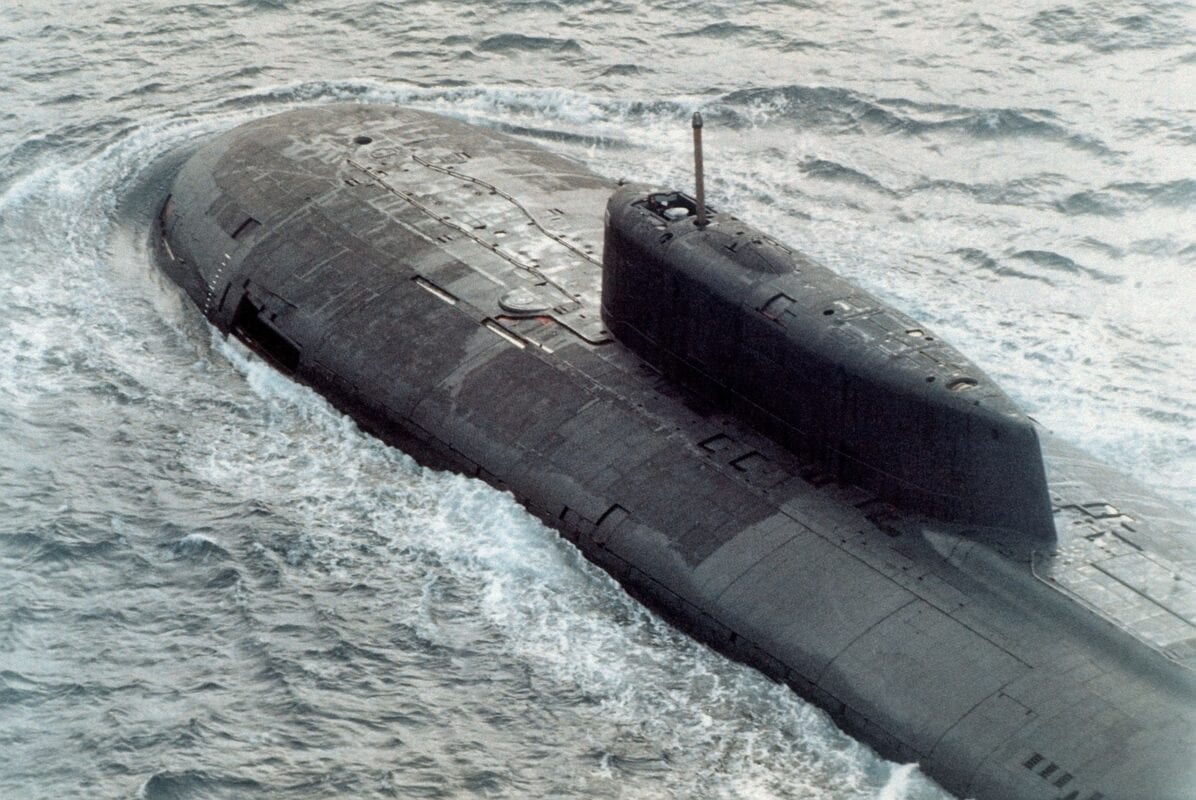Last year we shared the story of a Russian submarine accident with a relatively happy ending – happy enough, at least, since most of the Soviet crew survived when the K-19 wrecked, although 22 sailors did perish. By contrast, the Aug. 15, 2000, sinking of the Kursk was an unmitigated tragedy.
The Kursk incident also demonstrated – many years before the “special military operation” in Ukraine – Vladimir Putin’s penchant for needlessly squandering the lives of his country’s military servicemembers.
Profile of a Doomed Boat
The K-141 Kursk (Атомная Подводная Лодка «Курск») was a Project 949A/Antey-class (NATO reporting name Oscar II) nuclear cruise-missile submarine.
It was named after the Russian city that was the site of an epic tank battle in July 1943. Her keel was laid in 1990 at the naval shipyards in Severodvinsk.
When she was launched and commissioned in 1994, the Kursk became one of the first Russian naval vessels to be completed after the collapse of the USSR.
The Oscar II-class boats were 508 feet long with a beam of 60 feet, and they displaced 19,400 tons.
Designed to hunt American nuclear-powered supercarriers, the Soviet subs were powered by two OK-650 nuclear reactors that together provided 97,990 shipboard horsepower and a top submerged speed of 33 knots (16 knots while surfaced).
The large size of the Anteys accommodated their large payload, namely 24 P-700/SS-N-19 Granit missiles (NATO reporting name “Shipwreck”). These missiles were themselves the size of a small plane — they were 33 feet long and weighed 15,400 pounds.
Timeline of a Tragedy
On that fateful August day, the Kursk was participating in a major fleet exercise in the Barents Sea along with the aircraft carrier Admiral Kuznetsov and the battlecruiser Pyotr Velikiy. At the time, the K-141 had 118 officers and enlisted sailors on board, skippered by Capt. First Rank Gennady Petrovich Lyachin.
Popular Mechanics columnist Kyle Mizokami picks up the story from there:
“At 11:20 a.m. local time, an underwater explosion rocked the exercise area, followed two minutes later by an even larger explosion. A Norwegian seismic monitoring station recorded both explosions. One Russian account claims the 28,000-ton battlecruiser Pyotr Velikiy shook from the first explosion. Racked by explosions, Kursk sank in 354 feet of water at a 20-degree vertical angle. One of the explosions ripped a large gash in her forward bow, near the torpedo compartment. A Russian Navy board of inquiry later determined that one of the submarine’s Type 65-76A super heavyweight torpedoes had exploded, causing the gash. The explosion was likely caused by a faulty weld that failed to hold the hydrogen peroxide fuel chamber together. Like many torpedoes, the Type 65-76As used hydrogen peroxide as underwater fuel. The danger was that this chemical compound can become explosive if it comes into contact with organic compounds or a fire.”
(As a side note, U.S. Navy submariners can ruefully relate to faulty torpedoes, as evidenced by the sinking of the USS Tang during World War II.)
Amazingly, 23 of the sub’s crew initially survived the explosion. Among them was 27-year-old Capt. Lt. Dmitry Kolesnikov, who desperately and poignantly hand-scribbled a note addressed to his wife: “Olya, I love you … Here are the lists of the personnel of the departments, who are located in the 9th section and will be trying to get out. Hello to everybody. Don’t despair.”
This was followed later by the far less optimistic, “It’s dark to write here, but I will try to do it blindly. It looks that there are no chances — ten to twenty percent. We will hope that somebody will read this.”
Putin’s Dithering Dooms the Rest of the Crew
Dmitry and his comrades held out for roughly another four hours. Scandalously, Vladimir Putin —then just over three months into his first term as Russian president— refused Western offers of assistance.
The Russian navy did not dispatch its own search-and-rescue teams until the six-hour mark, finally sending mini-subs that were unable to hook onto the submarine’s escape hatch. As noted by a Navy Times article, “After a week, Russia finally invited Norwegian divers and it took them just hours to open the hatch, but by then it was too late to save anyone.”
On Aug. 26, Putin conferred a posthumous Hero of Russia title upon Captain Lyachin and awarded the Order of Courage to the 117 other crewmembers. Needless to say, this was slim comfort to their surviving loved ones. The Kursk’s wreckage was raised in October 2001, along with the remains of 115 of her crew, and towed to a floating dock at Roslyakovo.
As a postscript that adds a final degree of insult to injury, a retired Russian Admiral, Vyacheslav Popov, recently went on public record to claim that the sinking of the Kursk resulted from a collision with a NATO submarine.
This seems like a rather convenient deflection, for, as SOFPREP’s Steve Balestrieri points out, “Admiral Popov had received the brunt of the blame for the bungled and painfully slow rescue effort.”

Image: Creative Commons.

Image Credit: Facebook posting from Danish Navy.

Image: Facebook posting from Danish Navy.

Image: Creative Commons.
Christian D. Orr is a former Air Force officer, Federal law enforcement officer, and private military contractor (with assignments worked in Iraq, the United Arab Emirates, Kosovo, Japan, Germany, and the Pentagon). Chris holds a B.A. in International Relations from the University of Southern California (USC) and an M.A. in Intelligence Studies (concentration in Terrorism Studies) from American Military University (AMU). He has also been published in The Daily Torch and The Journal of Intelligence and Cyber Security. Last but not least, he is a Companion of the Order of the Naval Order of the United States (NOUS).
From 19FortyFive
Footage Shows World War I Guns Being Used in Ukraine
‘Vacuum Bombs Destroyed’: Ukraine Footage Shows Putin’s Thermobaric Rockets Destroyed
BOOM! Ukraine Video Shows Precision Strike on Russian Air-Defense System

